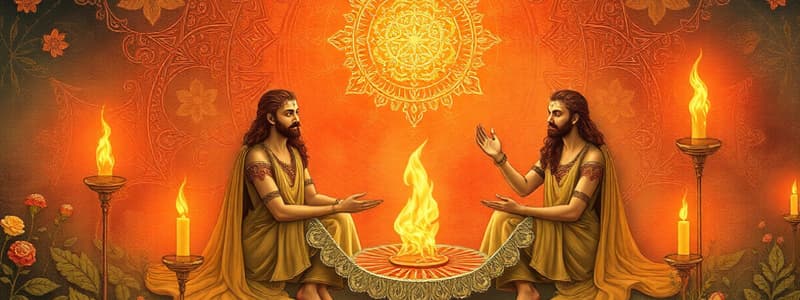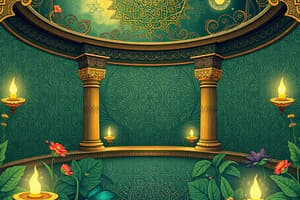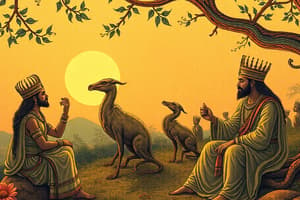Podcast
Questions and Answers
Which set of texts is traditionally considered part of the Vedas?
Which set of texts is traditionally considered part of the Vedas?
- Brahmanas, Aranyakas, and Puranas
- Jain Agamas, Tripitakas, and Bhagavad Gita
- Rigveda, Samaveda, Yajurveda, and Atharvaveda (correct)
- Ramayana, Mahabharata, and Upanishads
How do the Upanishads relate to the Vedas?
How do the Upanishads relate to the Vedas?
- They are considered the concluding parts of the Vedas, focusing on philosophy. (correct)
- They are independent texts with no direct connection to the Vedas.
- They are commentaries on the Vedas, explaining their rituals.
- They are older than the Vedas and served as the basis for them.
What distinguishes Prakrit literature from Classical Sanskrit literature?
What distinguishes Prakrit literature from Classical Sanskrit literature?
- Prakrit literature primarily consists of epics, while Sanskrit literature focuses on dramas.
- Prakrit literature uses vernacular languages of ancient India, while Sanskrit literature uses a more formal, standardized language. (correct)
- Prakrit literature is exclusively religious, while Sanskrit literature is entirely secular.
- Prakrit literature only emerged after the decline of Sanskrit literature.
Which of the following best characterizes the Bhakti movement's influence on medieval Indian literature?
Which of the following best characterizes the Bhakti movement's influence on medieval Indian literature?
In what way did modern Indian literature reflect the socio-political climate of its time?
In what way did modern Indian literature reflect the socio-political climate of its time?
How did the emergence of Indian literature in English impact the broader literary landscape?
How did the emergence of Indian literature in English impact the broader literary landscape?
What distinguishes contemporary Indian literature from its predecessors?
What distinguishes contemporary Indian literature from its predecessors?
What role do literary festivals and awards play in contemporary Indian literature?
What role do literary festivals and awards play in contemporary Indian literature?
Which of the following statements best describes the evolution of Indian literature over time?
Which of the following statements best describes the evolution of Indian literature over time?
How does diaspora literature contribute to contemporary Indian literature?
How does diaspora literature contribute to contemporary Indian literature?
Flashcards
The Vedas
The Vedas
A collection of hymns, prayers, and rituals, considered among the oldest texts in Indo-Aryan languages and foundational to Hinduism.
The Upanishads
The Upanishads
Philosophical texts that explore the nature of reality and the self, considered the concluding parts of the Vedas.
Ramayana
Ramayana
One of the two major Sanskrit epics of ancient India. It narrates the story of Rama, his exile, and his battle against Ravana.
Mahabharata
Mahabharata
Signup and view all the flashcards
Kalidasa
Kalidasa
Signup and view all the flashcards
Prakrit Literature
Prakrit Literature
Signup and view all the flashcards
Jain Agamas
Jain Agamas
Signup and view all the flashcards
Bhakti Poetry
Bhakti Poetry
Signup and view all the flashcards
Ramcharitmanas
Ramcharitmanas
Signup and view all the flashcards
Modern Indian Literature
Modern Indian Literature
Signup and view all the flashcards
Study Notes
- Indian literature includes works from the Indian subcontinent, starting with ancient oral traditions
- Works are written in languages like Sanskrit, Prakrit, Hindi, Tamil, Telugu, Bengali, Kannada, and English
- It mirrors the diverse culture, history, and religious traditions of the region
Ancient Indian Literature
- The earliest forms were oral, encompassing religious and philosophical texts
- The Vedas, among the oldest Indo-Aryan texts, are collections of hymns, prayers, and rituals, foundational to Hinduism
- The four Vedas: Rigveda, Samaveda, Yajurveda, and Atharvaveda
- The Upanishads are philosophical texts exploring reality and the self, considered concluding parts of the Vedas
- The Brahmanas are prose texts explaining Vedic rituals and sacrifices
- The Aranyakas, or "forest texts," interpret Vedic rituals and philosophical discussions
- The epics Ramayana and Mahabharata are central to Indian culture and Dharma
- Valmiki's Ramayana narrates Rama's story, exile, and battle against Ravana
- Vyasa's Mahabharata tells of the Kurukshetra War between the Pandavas and Kauravas, including the Bhagavad Gita
Classical Sanskrit Literature
- Includes drama, poetry, and prose
- Prominent playwrights: Kalidasa, Bhasa, and Sudraka
- Kalidasa's plays: "Abhijnanashakuntalam," "Vikramorvashiyam," and "Malavikagnimitram"
- Bhasa's plays: "Swapnavasavadattam" and "Urubhangam"
- Sudraka's "Mrichchhakatika" (The Little Clay Cart)
- Key poets: Kalidasa, Bharavi, and Magha
- Kalidasa's poems: "Meghaduta" and "Raghuvamsha"
- Bharavi wrote the epic poem "Kiratarjuniya"
- Magha wrote "Shishupala Vadha"
- Major prose writers: Dandin and Bana
- Dandin wrote "Dashakumaracharita" (Tales of the Ten Princes)
- Bana wrote "Kadambari" and "Harshacharita"
Prakrit Literature
- Developed alongside Sanskrit literature
- Prakrit languages were vernacular languages used in ancient India
- Includes religious texts of Jainism and secular literature
- The Jain Agamas are scriptures in Ardhamagadhi Prakrit
- "Gaha Sattasai" (or Gatha Saptasati) is an anthology of Prakrit poems attributed to Hala
Medieval Indian Literature
- Saw a rise of literature in various regional languages
- Bhakti poetry emerged, expressing devotion to various deities
- Prominent Bhakti poets: Kabir, Surdas, Tulsidas, Mirabai, and Guru Nanak
- Kabir's poems emphasized the unity of God
- Surdas wrote devotional poems dedicated to Krishna
- Tulsidas wrote "Ramcharitmanas," a retelling of the Ramayana in Awadhi
- Mirabai, a princess, composed devotional songs dedicated to Krishna
- Guru Nanak, the founder of Sikhism, whose hymns are included in the Guru Granth Sahib
- Sufi poetry flourished, emphasizing love and mystical experiences
- Important Sufi poets: Amir Khusrau and Malik Muhammad Jayasi
- Amir Khusrau wrote in Persian and Hindavi
- Malik Muhammad Jayasi wrote "Padmavat" in Awadhi
- Regional literature included epics, romances, and historical chronicles
- Examples: "Kamba Ramayanam" in Tamil by Kamban, "Pampa Bharata" in Kannada by Pampa, and "Sri Krishna Vijayam" in Malayalam by Cherusseri Namboothiri
Modern Indian Literature
- Reflects the impact of colonialism, nationalism, and social reform
- The novel emerged as a popular genre
- Key novelists: Bankim Chandra Chatterjee, Sarat Chandra Chattopadhyay, and R.K. Narayan
- Bankim Chandra Chatterjee wrote "Anandamath"
- Sarat Chandra Chattopadhyay is known for "Devdas" and "Parineeta"
- R.K. Narayan is famous for "Malgudi Days" and "The Guide"
- Prominent poets: Rabindranath Tagore, Subramania Bharati, and Sarojini Naidu
- Rabindranath Tagore won the Nobel Prize in Literature in 1913
- Subramania Bharati was a Tamil poet and freedom fighter
- Sarojini Naidu is known as the "Nightingale of India"
- Playwrights like Mohan Rakesh, Vijay Tendulkar, and Girish Karnad made significant contributions
- Short stories gained popularity
- Premchand is considered a pioneer of the Hindi short story
- Other notable short story writers: Ismat Chughtai and Saadat Hasan Manto
- Indian literature in English gained prominence
- Notable Indian English writers: Mulk Raj Anand, Raja Rao, Salman Rushdie, and Arundhati Roy
- Mulk Raj Anand is known for "Untouchable" and "Coolie"
- Raja Rao wrote "Kanthapura"
- Salman Rushdie is famous for "Midnight's Children"
- Arundhati Roy won the Booker Prize for "The God of Small Things"
Contemporary Indian Literature
- Continues to evolve, addressing contemporary social, political, and cultural issues
- New voices and perspectives are emerging in various languages
- Postcolonial themes are explored
- Writers engage with globalization, identity, and social justice
- Diaspora literature forms a significant part
- Writers of Indian origin living abroad contribute to Indian literature
- Notable contemporary authors: Amitav Ghosh, Vikram Seth, Jhumpa Lahiri, and Aravind Adiga
- Literary festivals and awards promote Indian literature
- Examples: the Jaipur Literature Festival and the Sahitya Akademi Awards
Studying That Suits You
Use AI to generate personalized quizzes and flashcards to suit your learning preferences.




